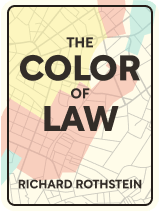

This article is an excerpt from the Shortform book guide to "The Color of Law" by Richard Rothstein. Shortform has the world's best summaries and analyses of books you should be reading.
Like this article? Sign up for a free trial here .
How did the government enable housing segregation in the 1950s? What was the role of the Housing Act of 1949 in facilitating this segregation?
The segregationist stance of the government with policies such as school placement, slum clearance, and segregated housing projects all contributed to pervasive housing segregation in the 1950s. The Housing Act of 1949 permitted public authorities to segregate within housing projects which gave legal justification to segregationist practices in 1950s housing.
Read on to learn more about housing segregation in the 1950s.
How Federal Housing Policy Facilitated 1950s Housing Segregation
The government’s support for segregation in public housing remained constant in the decade after the war. In 1949, spurred by thousands of returning GIs, Congress passed the Housing Act, which reestablished a federal housing program. To get the necessary votes from southern Democrats to pass the Act, northern Democrats had to strip the law of any integration amendments. The Act as passed permitted local authorities to segregate within or between projects.
The funds from the Housing Act went to establish segregated high-rise projects like Rosen Homes and Schuylkill Falls in Philadelphia, Van Dyke Houses in New York, and Robert Taylor and Cabrini Green Homes in Chicago. Many of these projects still exist (and remain segregated).
In 1952, the Truman administration attempted to reduce the inequities caused by segregated public housing by adopting a new rule: Local housing authorities receiving federal funds had to build Black-only housing projects in proportion to need. All too often vacancies in white-only projects were left unfilled—due to whites’ higher incomes and better treatment in the private real estate market—whereas long waiting lists for Black-only projects were common. The rule would force localities to build new units to satisfy existing need among African Americans.
However, the government’s enablement of housing segregation in the 1950s continued with the election of Dwight D. Eisenhower, and the Republican Party’s adoption of a segregationist stance, any incrementalist steps toward a more equitable public housing policy were ended. The Eisenhower administration did away with a policy that mandated that housing for African Americans and whites be of equal quality. Likewise, they stopped enforcing Truman’s policy of addressing housing need, regardless of race.
The Role of Local Governments in Furthering Housing Segregation in the 1950s
As much as federal policy contributed to racial residential segregation, the small-scale efforts by state and municipal governments to keep their communities segregated; when considered in their totality, clearly point to a system of de jure segregation in the United States.
Slum Clearance
White community groups and public officials weren’t only concerned with excluding African Americans from residential areas—they also made concerted efforts to remove them from urban downtowns and business districts. (These were the areas into which Blacks had been pushed due to discrimination in the suburbs.) To reserve these economically important areas for whites, officials practiced “slum clearance”: the condemnation and demolition of dilapidated structures and the forced relocation of their current residents.
The most common impetus for slum clearance was infrastructure projects, in particular the federal interstate highway system. For example, in 1956, the Florida State Road Department routed a section of I-95 through a Black enclave adjacent to Miami’s downtown. By the time of the highway’s completion in the 1960s, the area’s African-Ameircan population of 40,000 had been reduced to 8,000.
School Placement
Prior to Brown v. Board of Ed., the famous 1954 Supreme Court case ending the doctrine of “separate but equal” in US public schools, many states used the location of segregated public schools to practice racial residential segregation.
One prominent example concerns Austin, TX. In its 1928 “Master Plan,” the city evaded a Supreme Court ruling that housing segregation on the basis of race was unconstitutional by placing a variety of Black-only services, including public schools, on the city’s Eastside. The effect was significant: In 1930, the African American population of the integrated Wheatsville neighborhood was 16%; by 1950, after the segregated school for African Americans was shuttered, it was 1%.
State-Sanctioned Violence to Further Segregation
In addition to the various city-planning methods just discussed, officials also leveraged law enforcement—or, rather, the selective enforcement of the law—to entrench housing segregation in the 1950s. When Black families attempting to integrate white neighborhoods were subjected to vicious harassment, elected officials and law enforcement officers often tolerated—and sometimes actively encouraged—that harassment.
It’s important to note that, in general, government can’t be held responsible for the intimidation tactics—verbal abuse, property damage, and, ultimately, physical violence—used by white supremacists to defend segregation. However, when public authorities either turn a blind eye or, worse, encourage that intimidation, it amounts to an unconstitutional infringement of African Americans’ rights and de jure segregation.
The Role of the Real Estate Lobby
From the postwar period on, the real estate lobby—a group of professionals hired to represent the real estate industry to members of Congress—helped speed the racial residential segregation in 1950s housing.
First, it pressured Congress to lower the maximum income requirements for public-housing eligibility. As a result, many middle-class families, both white and black, were forced out of projects and into the housing market, and projects became the exclusive redoubt of the poor. These poor, due to discrimination in the labor market (see Chapter 10), were almost exclusively African American.
The repercussions of this shift were multiple. Poor residents of projects didn’t have the resources to maintain the projects themselves, and the government deprived them of the necessary subsidies. These residents also lacked the political strength to insist on better amenities. Thus, in addition to becoming monoracial, the quality of life in public 1950s housing declined precipitously.
By the early 1970s, public housing’s reputation as “rundown” and “crime-ridden”—as Richard Nixon testified in 1973—was widespread, a reputation that clung to its primary beneficiaries: Black Americans.

———End of Preview———
Like what you just read? Read the rest of the world's best book summary and analysis of Richard Rothstein's "The Color of Law" at Shortform .
Here's what you'll find in our full The Color of Law summary :
- How racial residential segregation is the result of explicit government policy
- The three reasons why racial segregation is so difficult to reverse
- The steps that could lead to a more integrated and equitable society






